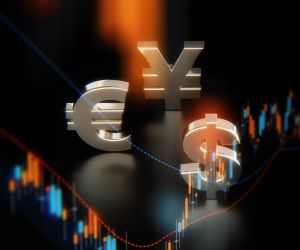BENCHMARKS AND THEIR ROLE IN FOREX MARKETS
Benchmarks in Forex serve as reference points that guide pricing, performance measurement, and risk management. They include widely followed rates, indexes, and standards that bring structure to a decentralised global market. From WM/Reuters fixings to central bank reference rates, benchmarks influence everything from trade execution to portfolio evaluation. Understanding which benchmarks matter and how they are applied helps traders and institutions navigate the currency market with greater precision.

Benchmark Basics
In finance, benchmarks are like yardsticks. They provide reference points against which performance, prices, and strategies can be measured. In equity markets, benchmarks take the form of indices such as the S&P 500 or the FTSE 100. In bond markets, they include government yields that define the risk-free rate. In the foreign exchange (FX) market, benchmarks serve a similar role, anchoring a decentralised and constantly moving marketplace. They help traders and institutions answer the question: “What is the fair price of a currency at a given time?”
Why Benchmarks Matter in FX
The Forex market is the largest and most liquid in the world, but it is also decentralised. Unlike stocks, which trade on centralised exchanges, currencies are traded across a global network of banks, brokers, and electronic platforms. This means there is no single “official” price for any given currency pair at any moment. Benchmarks fill this gap by providing a standardised price or rate that participants can use to compare and evaluate trades. They are crucial for both transparency and accountability.
For example, an asset manager who needs to demonstrate that their FX execution was fair and competitive cannot simply pick an arbitrary price. They must compare it against a recognised benchmark such as the WM/Reuters London 4 p.m. fix. Without such benchmarks, disputes over execution quality or portfolio performance would be far more common.
Types of FX Benchmarks
Several types of benchmarks are used in FX markets, each serving different functions. The most widely followed include:
- Fixing Rates: These are set at specific times of day to provide a snapshot of exchange rates. The most famous is the WM/Reuters fix, used by asset managers and index providers for valuation and settlement purposes.
- Central Bank Reference Rates: Many central banks, including the European Central Bank and the People’s Bank of China, publish daily reference rates that guide market participants.
- Indexes: Currency indexes such as the U.S. Dollar Index (DXY) measure the value of a currency relative to a basket of others, serving as broad benchmarks for strength or weakness.
- Trade-Weighted Averages: These benchmarks calculate a currency’s value against its major trading partners, often used by policymakers and analysts to assess competitiveness.
The WM/Reuters Fix as a Benchmark
Among FX benchmarks, the WM/Reuters fix stands out as the most influential. It provides standardised exchange rates for a wide range of currencies, calculated using transaction data from leading trading platforms during a short time window (commonly around 4 p.m. London time). The fix is used by index providers, fund managers, and custodians to value portfolios and settle transactions. For example, when a global equity index is rebalanced, billions of dollars’ worth of FX transactions are executed at the WM/Reuters fix to ensure consistency across markets.
The popularity of the fix stems from its perceived neutrality. By averaging real trades over a set period, it aims to reduce the influence of outliers or manipulation. That said, it has also been at the centre of regulatory scrutiny, particularly after allegations in the early 2010s that traders colluded to influence fix prices. This episode underscored the importance of benchmarks—and the risks when their integrity is compromised.
Benchmarks for Hedging and Valuation
Benchmarks are not just about settlement; they also support hedging and valuation. Multinational corporations use benchmark rates to value currency exposures across subsidiaries. Hedge funds track benchmarks to assess whether their strategies outperform a standard reference. Central banks themselves sometimes monitor benchmark indexes to evaluate whether their currency is over- or undervalued relative to peers.
For instance, a Japanese exporter might invoice sales in U.S. dollars but measure performance against the yen. By referencing the WM/Reuters fix, the company ensures that its hedging programme aligns with widely accepted market standards. This makes its financial reporting more credible to investors and auditors.
Challenges of Using Benchmarks
While benchmarks bring order to the FX market, they also have limitations. Because they are snapshots, they may not reflect the best available prices outside the fixing window. Large orders executed during the fix can also influence the rate itself, creating distortions. In addition, not all benchmarks are equally reliable. Some central bank reference rates are calculated using opaque methods, leaving traders uncertain about how representative they are.
These challenges highlight the need for careful interpretation. A benchmark should be seen as a guide, not an absolute truth. Experienced traders understand its context, using it as one of several inputs into their decision-making rather than the sole determinant.
Why Benchmarks Are Essential
Despite their imperfections, benchmarks are indispensable. They provide transparency, facilitate fair dealing, and anchor a market that might otherwise seem chaotic. Without benchmarks, it would be nearly impossible to measure execution quality, value portfolios consistently, or compare strategies across firms. For traders, the practical takeaway is clear: benchmarks are not just background noise, they are signals that help frame the entire FX landscape.
Key FX Benchmarks
Foreign exchange benchmarks come in many forms, but a handful dominate day-to-day trading, portfolio management, and policy discussions. Each has its own methodology, history, and purpose. Together, they provide the structure needed to bring consistency to a market that otherwise functions as a loosely connected web of banks, funds, corporates, and retail participants. Understanding these benchmarks helps traders place individual price moves in a broader context and appreciate how professional investors evaluate currency risk.
The WM/Reuters London Fix
The most widely recognised benchmark in global FX is the WM/Reuters London fix. It is calculated each day around 4 p.m. London time, a moment chosen because it overlaps both the European and U.S. trading sessions. During a short window—traditionally one minute, later expanded after regulatory scrutiny—actual transaction data from major platforms such as Refinitiv and EBS are collected and averaged to produce a representative exchange rate for a wide range of currency pairs.
The London fix has enormous practical significance. Asset managers use it to value portfolios, index providers to settle global equity and bond indices, and custodians to execute client orders. When a fund rebalances against an equity index, the FX trades required to adjust exposures are often executed at the fix, creating predictable surges in volume. This concentration of activity explains why some traders specialise in “fixing trades”, positioning themselves ahead of anticipated flows.
Central Bank Reference Rates
Many central banks publish daily reference rates that serve as benchmarks for both domestic and international users. The European Central Bank, for example, issues a set of euro foreign exchange reference rates once per day, based on a concerted process among participating banks. The People’s Bank of China sets the daily midpoint for the yuan against the dollar, a rate that guides trading within a permitted band. These reference rates are closely watched because they reveal both official policy preferences and prevailing market conditions.
For corporates and investors, central bank reference rates provide a reliable anchor for valuation and reporting. A multinational firm might use the ECB reference rates to convert revenues from subsidiaries into euros for consolidated accounts. Likewise, emerging-market companies often price international bonds or derivatives off their central bank’s published rate. Even if the rate does not match the most liquid market price at every moment, its official status makes it valuable for legal and accounting purposes.
The U.S. Dollar Index (DXY)
The U.S. Dollar Index, or DXY, is another widely followed benchmark. First introduced in the 1970s, it measures the dollar’s value against a basket of major currencies, including the euro, yen, pound, Canadian dollar, Swedish krona, and Swiss franc. Because the euro carries a heavy weighting, the index is often viewed as a proxy for EUR/USD performance. Nonetheless, traders and economists alike use DXY as a barometer of global dollar strength or weakness.
For Forex traders, DXY serves as a backdrop. A rising DXY indicates broad-based dollar strength, providing context when evaluating pairs such as USD/JPY or GBP/USD. Conversely, a falling index often accompanies rallies in commodities like gold and oil, as these are priced in dollars. While no one trades DXY directly in the spot market, derivatives linked to the index allow investors to hedge or speculate on the dollar as a whole, making it a benchmark in both psychological and practical terms.
Trade-Weighted Indexes
Beyond the DXY, many countries maintain trade-weighted currency indexes. These measure the value of a currency against the currencies of its largest trading partners, weighted by trade volumes. The Bank of England publishes an effective exchange rate index for sterling, while the Reserve Bank of Australia does the same for the Aussie dollar. These indexes are especially useful for policymakers, because they show whether a currency is gaining or losing competitiveness in international trade.
For market participants, trade-weighted indexes provide insight that goes beyond bilateral pairs. For example, GBP/USD may be rising, but if sterling is weakening against other European currencies, the trade-weighted index might show deterioration in competitiveness. This broader perspective allows traders and businesses to anticipate shifts in export performance, inflation pressures, and central bank responses.
Emerging Market Benchmarks
Emerging-market currencies present unique challenges for benchmarks, given that liquidity is often thin and trading fragmented. To address this, institutions such as JPMorgan have created proprietary indexes—like the JPMorgan Emerging Market Currency Index (EMCI)—to track baskets of emerging-market currencies. These benchmarks are used by asset managers to design exchange-traded funds (ETFs) and other products that offer exposure to EM currencies without requiring direct participation in illiquid markets.
Another benchmark of note is the CFETS RMB Index, introduced by China’s central bank. It measures the yuan against a broader basket of currencies rather than just the U.S. dollar, providing an official gauge of how the Chinese currency is performing globally. For international investors, it serves as a clue to Beijing’s policy intentions and tolerance for appreciation or depreciation.
Specialised Benchmarks for Derivatives
Benchmarks are also critical in the derivatives space. Cross-currency swaps, options, and forwards often reference published rates or indexes to set terms. For instance, ISDA—the International Swaps and Derivatives Association—oversees a range of standardised benchmarks used in contract documentation. These ensure that counterparties agree on a common reference point, reducing disputes and systemic risk. In highly leveraged and complex markets, such standardisation is not just convenient, it is essential for stability.
Lessons from Benchmark Scandals
FX benchmarks have not been immune from controversy. Investigations in the early 2010s revealed that some traders attempted to manipulate the WM/Reuters fix by colluding in chat rooms to influence rates during the fixing window. The scandal led to billions in fines and widespread reforms, including longer calculation windows and stricter oversight. The episode served as a reminder that benchmarks are only as credible as the integrity of the processes behind them.
Today, regulators continue to monitor FX benchmarks closely. The Financial Stability Board (FSB) has pushed for reforms to ensure that they are transparent, representative, and resistant to manipulation. For traders and investors, this history underscores the importance of scrutinising not only the numbers themselves but also the methodologies that produce them.
Why Traders Monitor Benchmarks Daily
Professional traders and analysts keep a close eye on benchmarks because they provide a pulse check on the market. If DXY is rising sharply, it signals dollar demand across multiple fronts. If the WM/Reuters fix shows unusual volatility, it may hint at large institutional flows. And if trade-weighted indexes move significantly, it may indicate shifts in competitiveness that could affect inflation or central bank policy. In short, benchmarks serve as signals embedded within the noise of daily FX trading.
Trading Applications
Benchmarks are not simply academic constructs or tools for regulators. For traders, they provide real, actionable signals that can shape intraday decisions, longer-term strategies, and risk management frameworks. By interpreting benchmark movements intelligently, market participants can identify opportunities, avoid pitfalls, and align their trading with the broader flows driving the currency market.
Using Fixings for Execution
The WM/Reuters fix is one of the most widely used execution points for institutional orders. Large asset managers, pension funds, and index trackers often instruct their banks to transact at the fix to ensure consistency with benchmark valuations. For traders, this predictable behaviour creates both risks and opportunities. Liquidity surges around the fixing window can generate sharp, temporary moves as banks hedge client orders in the minutes leading up to and after the official rate is published.
Savvy short-term traders monitor these flows closely. Anticipating whether demand will be skewed towards buying or selling allows them to position ahead of the wave. However, the practice requires discipline. The concentration of orders can produce exaggerated volatility, and being caught on the wrong side of a fixing flow can lead to rapid losses. For this reason, many retail traders are advised to avoid the 4 p.m. London window unless they have a clear understanding of the underlying dynamics.
Benchmarks in Portfolio Hedging
Institutional investors with global exposures use benchmarks as the foundation for hedging strategies. A fund manager holding Japanese equities denominated in yen, for example, may monitor the DXY or the yen’s trade-weighted index to decide how much currency risk to hedge. By aligning hedging decisions with recognised benchmarks, managers can demonstrate to clients that they are managing exposures in line with industry standards rather than making arbitrary decisions.
Benchmarks also provide transparency. If a hedge underperforms because the yen diverges from its trade-weighted benchmark, the fund can explain the outcome in objective terms. This helps build trust with investors, regulators, and auditors, who expect a clear rationale behind risk management decisions. For traders, the lesson is simple: benchmarks can serve as an impartial yardstick against which performance and strategy are measured.
Interpreting DXY in Daily Trading
For day traders and swing traders, the U.S. Dollar Index is one of the most valuable benchmarks to monitor. Because so many currencies trade against the dollar, movements in DXY often set the tone for the entire FX market. If the index is trending higher, it is a strong signal that dollar strength is broad-based, not confined to one or two pairs. This context can prevent traders from misinterpreting isolated moves as idiosyncratic when they are actually part of a global pattern.
For example, if EUR/USD is falling, checking the DXY can clarify whether the move is driven by euro weakness specifically or general dollar strength. If the latter, traders may find opportunities in other pairs such as GBP/USD or AUD/USD that are likely to exhibit similar dynamics. In this way, benchmarks like DXY help traders build a coherent narrative across the market rather than reacting to isolated price action.
Trade-Weighted Indexes as Policy Guides
Central banks often reference trade-weighted indexes when discussing monetary policy. A sharp appreciation in a currency’s effective exchange rate can tighten financial conditions by making exports less competitive, even if headline inflation remains subdued. Traders who monitor these benchmarks gain an early read on potential policy shifts. If the Bank of England comments on sterling’s trade-weighted strength, for instance, it may foreshadow a dovish tilt in interest rate policy, which could weigh on GBP/USD.
For traders, this means trade-weighted benchmarks are not just abstract calculations. They directly influence central bank narratives, which in turn affect expectations and positioning in the currency market. Integrating these signals into trading strategies can provide an edge over those who focus only on bilateral pairs.
Benchmarks in Algorithmic Trading
The rise of algorithmic trading has further increased the importance of benchmarks. Many execution algorithms are designed to minimise slippage against the WM/Reuters fix or to track performance relative to DXY. Quantitative funds may also use benchmark indexes as inputs in models that forecast volatility or correlations. As a result, benchmark movements can trigger cascades of algorithmic orders, amplifying trends or reversing them abruptly.
For discretionary traders, this underscores the need to respect benchmark-driven flows. A sudden spike around the fix or a sharp DXY move may not reflect new fundamental information but rather mechanical adjustments by algorithms. Recognising these patterns can help traders avoid false signals and instead position themselves alongside structural flows.
Practical Lessons for Traders
For individual traders, the practical applications of benchmarks boil down to three key lessons. First, always check benchmarks for context before placing trades. A move that looks compelling in one pair may be explained entirely by broad benchmark trends. Second, be aware of benchmark-driven liquidity events, especially around fixings, to avoid being caught by sudden volatility. Third, use benchmarks as a compass for strategy alignment, ensuring that your trades fit within the bigger picture rather than fighting against it.
Ultimately, benchmarks provide a bridge between the micro-level of individual trades and the macro-level of global market flows. By incorporating them into daily practice, traders can navigate the FX market with greater clarity and discipline, making informed decisions that stand up to both scrutiny and market turbulence.







